The stolen treasures that were sensationally returned
Lost and found masterpieces
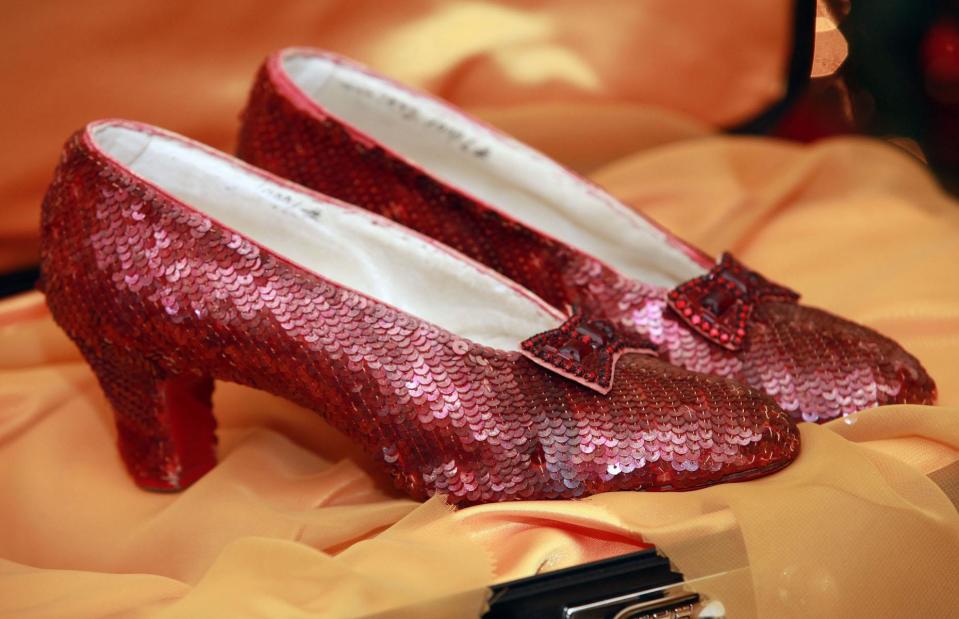
Astrid Stawiarz/Getty Images
World-famous paintings, historic artefacts, and irreplaceable jewels all have one thing in common: they can prove irresistible to crooks.
From priceless artworks such as the Mona Lisa to the ruby slippers from The Wizard of Oz, read on to uncover the incredible stories behind the missing treasures that were stolen and later returned, often in sensational circumstances.
All dollar amounts in US dollars and historic currency conversions correct for the time.
The US Bill of Rights
![<p>1st United States Congress/Wikimedia Commons [Public domain]</p>](https://s.yimg.com/ny/api/res/1.2/bKUUK9akmGY8rUP22QbWeg--/YXBwaWQ9aGlnaGxhbmRlcjt3PTk2MDtoPTYxOQ--/https://media.zenfs.com/en/lovemoney_uk_264/f25236a8b991624e76dd7bc517683242)
1st United States Congress/Wikimedia Commons [Public domain]
America’s Bill of Rights was written out 14 times in 1789 so that copies could be sent to the 11 existing states, as well as to Rhode Island and North Carolina, which were yet to adopt the Constitution. In 1865, a Union soldier fighting in the Civil War stole North Carolina’s Bill as a souvenir. He sold the historic parchment to businessman Charles Shotwell for just $5, the equivalent of around $85 (£67) today.
In the 1920s, a representative for Shotwell's family tried to sell the Bill back to North Carolina but officials insisted it was government property and turned down the offer. A further attempt to sell it back to the state was made by an anonymous party in 1995, which was once again refused.
But when an attempt was made to sell the document for $4 million (£2.5m) to Philadelphia Museum in 2003, FBI agents stepped in and seized it. A court declared it the official property of North Carolina and it was finally returned home.
Mona Lisa by Leonardo da Vinci
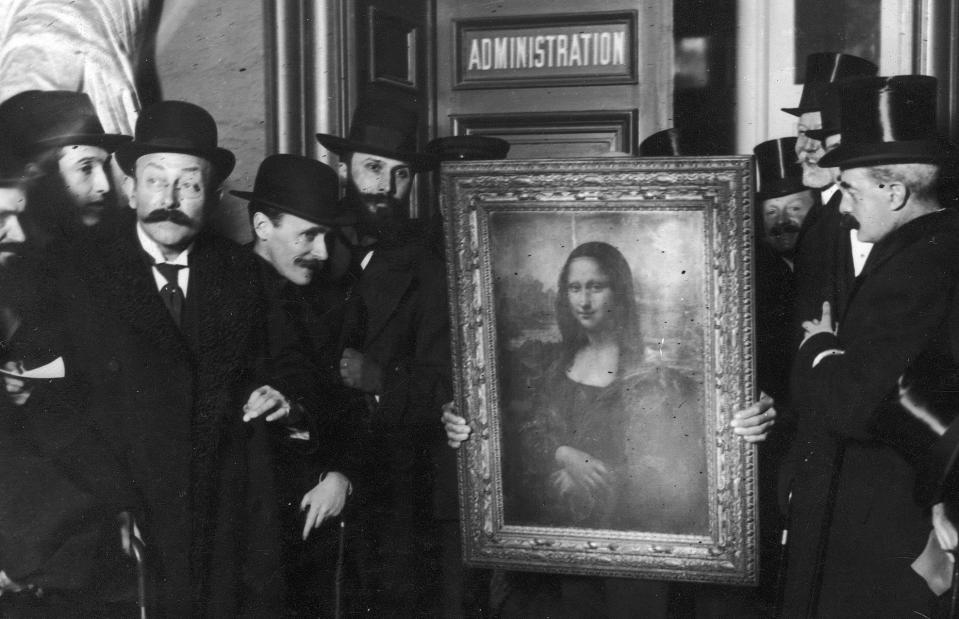
Paul Thompson/FPG/Archive Photos/Getty Images
In 1911, the Louvre in Paris hired an Italian man named Vincenzo Perugia to fit some protective glass cases around some of its artworks. Little did they know that Perugia was a petty criminal who had spotted an opportunity...
Perugia hid until the museum's staff had gone home and then removed the Mona Lisa from its frame, casually strolling out with it when the Louvre reopened the next morning.
In November 1913, he wrote to an art dealer in Florence called Alfredo Geri under the pseudonym "Leonardo Vincenzo". He travelled to meet Geri in Milan, hiding the masterpiece in the false bottom of a trunk. Geri persuaded the thief to leave the painting with him while he sought the opinion of an expert. He actually alerted the authorities and Perugia was promptly arrested, and the Mona Lisa was returned.
The "most stolen" artwork of all time
![<p>Jan van Eyck/Wikimedia Commons [Public domain]</p>](https://s.yimg.com/ny/api/res/1.2/435FRuAQgRZWemV5TzfO4g--/YXBwaWQ9aGlnaGxhbmRlcjt3PTk2MDtoPTYxOQ--/https://media.zenfs.com/en/lovemoney_uk_264/feca63c9bc6731138b10d018f77011ba)
Jan van Eyck/Wikimedia Commons [Public domain]
Boasting the dubious accolade of being the "most stolen" artwork of all time, Hubert and Jan van Eyck’s Adoration of the Mystic Lamb, also known as the Ghent Altarpiece, was painted in 1432 for St Bavo’s Cathedral in Ghent, Belgium.
The 12-panelled masterpiece by the Van Eyck brothers has attracted a lot of unwanted attention. In the early 1800s, Napoleon Bonaparte reportedly delivered the masterpiece to the Louvre in Paris, and it was only returned to Ghent after the Battle of Waterloo in 1815. In 1940, it was sent to the Vatican for safekeeping during World War II but only made it as far as a museum in Pau, France. Two years later, Adolf Hitler seized the artwork and it was stored in an Austrian salt mine. In 1945, it was recovered by a team from the Allied countries' Monuments, Fine Arts, and Archives Program, and returned to Belgium.
The theft-prone masterpiece received a new €30 million ($35m/£26m) bulletproof home in 2021. However, it's too late for one portion of the painting: the lower left panel of the Altarpiece was stolen in April 1934 from the St Bavo Cathedral and remains lost to this day. A ransom demand for one million Belgian francs was made at the time but the authorities refused to pay.
A possible culprit, Arsène Goedertier, confessed to the theft on his deathbed in December 1934 but refused to reveal where he had hidden the painting. It remains missing and is presumed destroyed. Now protected in its bulletproof case, the Belgian authorities can only hope that the remainder of the Altarpiece doesn't go walkabouts again.
The Duke of Wellington by Francisco Goya
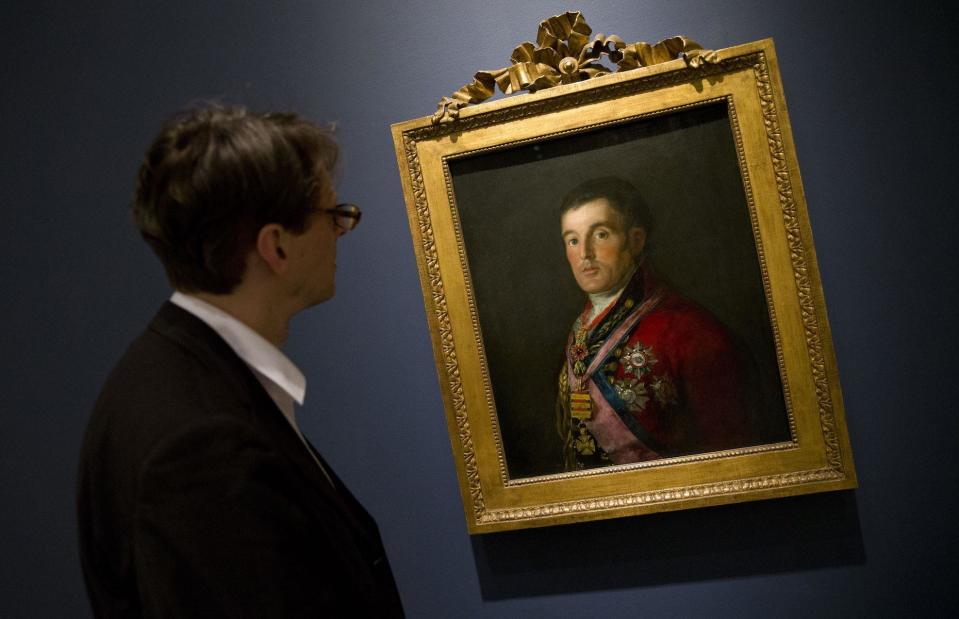
JUSTIN TALLIS/Stringer/Getty Images
In 1961, a portrait of the Duke of Wellington (pictured) by the Spanish artist Francisco Goya was stolen from the National Gallery in London. The theft happened just 19 days after the gallery had put it on display, having bought it for £140,000 (the equivalent of around £3m/$4m today) at auction. It was the first time anything had been stolen from the National Gallery and police launched a nationwide search for the criminal responsible for the heist.
Four years later, the thief handed back the painting and gave himself up to the authorities. Kempton Bunton was a 61-year-old former bus driver from Newcastle, England who, along with his son John, had stolen the portrait with the aim of selling it back to the National Gallery. Bunton hoped to use the proceeds to fund free TV licences for the elderly, a cause he was so passionate about that he'd previously gone to prison for refusing to pay his own licence.
Kempton's grandson, Chris Bunton, had the idea to turn the incredible story into a movie and The Duke, starring Jim Broadbent and Helen Mirren, was released in 2020.
Rufino Tamayo's Tres Personajes
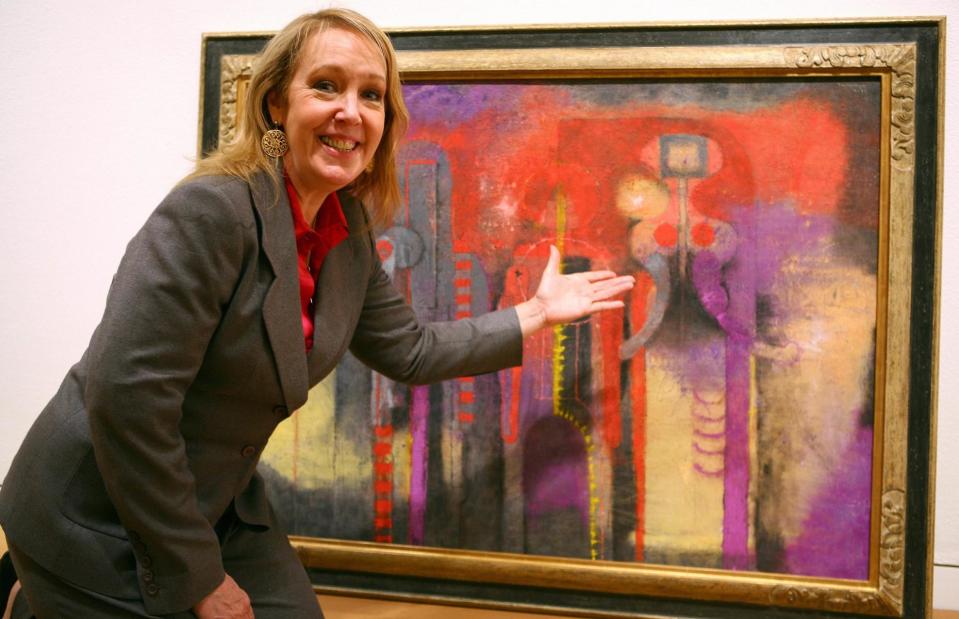
EMMANUEL DUNAND/Getty Images
The 1970 painting Tres Personajes was snapped up at a Sotheby’s modern art sale in 1977. Just 10 years later, the artwork was found to have vanished from the storage warehouse where the owners had left it for safekeeping. Detectives hunted for the painting for decades to no avail, but luckily an unsuspecting passer-by had a little more luck…
Elizabeth Gibson (shown here with the painting) stumbled across the abandoned artwork on her morning walk around Manhattan’s Upper West Side in 2003. Gibson was no art expert but took a shine to the painting, which had been dumped in the trash. She displayed it in her home for several months, and it was only at the suggestion of a friend that she got the painting assessed and its true value was revealed.
The stolen piece was finally returned to its rightful owner and went on to sell for $1,049,000 (£863k) at auction in 2007. Gibson received a $15,000 (£8k) reward for her help and an undisclosed percentage of the auction money.
The Scream by Edvard Munch
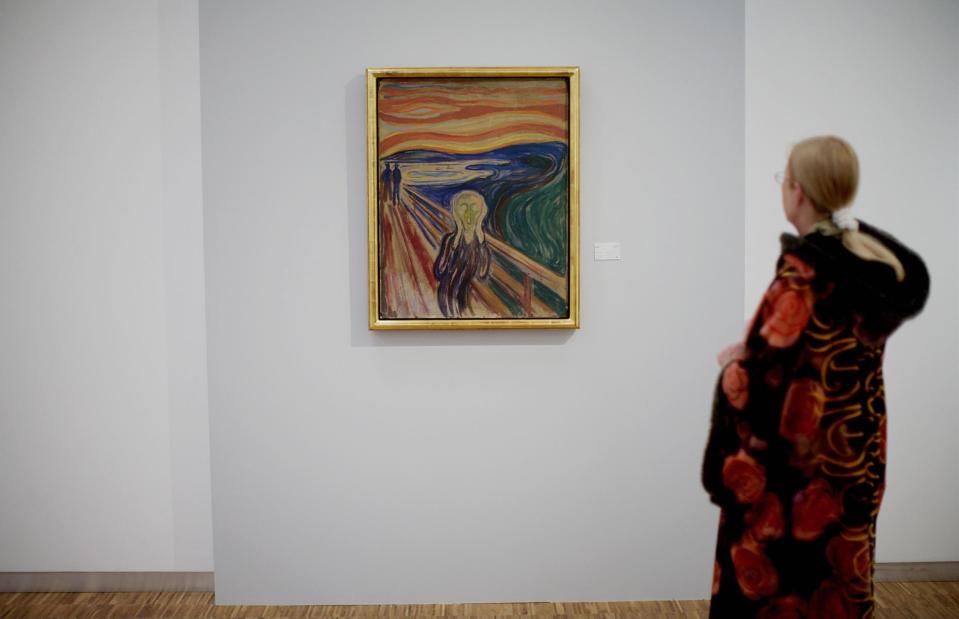
AFP/Stringer/Getty Images
The Scream is one of the most recognisable artworks in the world. There are actually four versions of it, all created by Edvard Munch, and two of these have been targeted by thieves.
One was stolen from Oslo's National Gallery in 1994, with robbers climbing a ladder, sneaking inside, nabbing the painting, and leaving behind a postcard that read: "Thanks for the poor security". Another was taken at gunpoint from the Munch Museum, also in Oslo, a decade later.
Thankfully, both works were recovered. The first thief held the painting to ransom, demanding $1 million (£820k) for its safe return, although a major undercover sting operation saw the work retrieved just a few months later without the fee being paid. The second Scream was recovered, along with Munch's The Madonna painting, in 2006, with both pieces having sustained some minor damage.
Whitworth Art Gallery trio
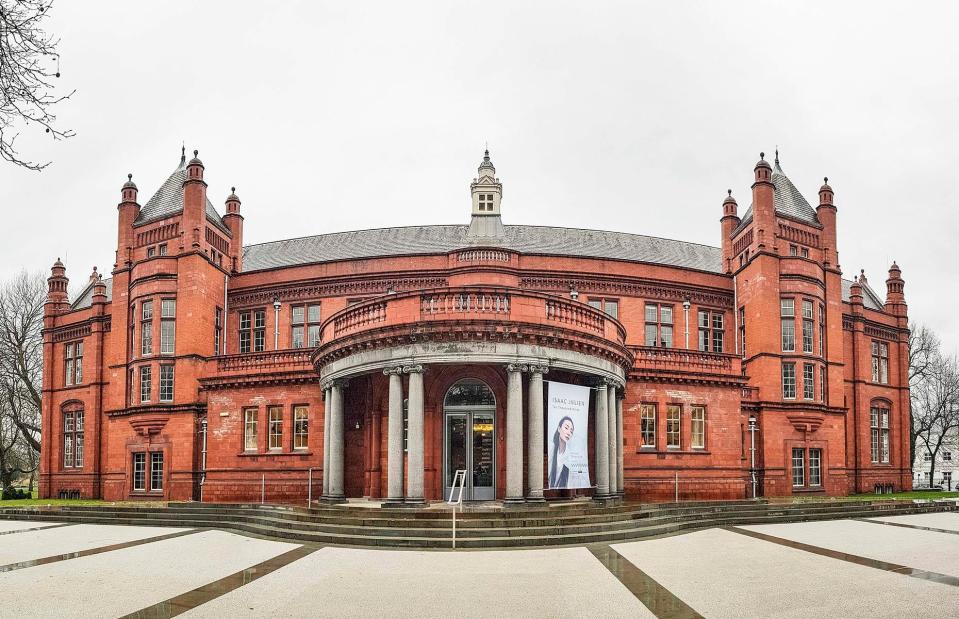
Alastair Wallace/Shutterstock
The Whitworth Art Gallery (pictured) in Manchester, England, saw three of its most famous works stolen in 2003. The prized paintings, by Pablo Picasso, Vincent Van Gogh, and Paul Gauguin, were noted as missing on 23 April after thieves entered the building overnight in an undetected raid. White spaces on the walls greeted the guards the next morning, with the missing paintings worth around $5 million (£4m) in total.
A couple of days after the theft, the paintings were discovered in a nearby public toilet. They had been rolled up inside a cardboard tube and were accompanied by a note that read: "We did not intend to steal these paintings, just to highlight the woeful security". Whether this was the real intention or not, we'll never know – and, of course, the UK press had a great time referring to the toilet treasure trove as "the Loo-vre".
Gotland’s Viking treasure
![<p>W.carter/Wikimedia Commons [CC BY-SA 4.0 DEED]</p>](https://s.yimg.com/ny/api/res/1.2/8bcRdlrV5As3XfL_lYkKKg--/YXBwaWQ9aGlnaGxhbmRlcjt3PTk2MDtoPTYxOQ--/https://media.zenfs.com/en/lovemoney_uk_264/f8dc61ab37c92a1a88b7cd1f8ddc5388)
W.carter/Wikimedia Commons [CC BY-SA 4.0 DEED]
Buried on an ancient Viking site, this treasure trove comprised 2,000 English, German, and Arabian silver coins, 1,000 of which were stolen by looters.
Classed as a cultural heritage crime, the coins were taken from a field in Gandarve in Gotland, Sweden in 2009, but due to rain washing the evidence away, any hope of recovering them seemed low. Luckily, a small piece of an 11th-century crucifix was dropped at the crime scene, which tallied with an image of part of a crucifix up for sale discovered in an email several days later.
The person sending the email led investigators to the thieves and a subsequent raid on a Gotland property resulted in their arrest. The coins were recovered in 2010.
Nicolas Cage's Action Comics #1

TIMOTHY A. CLARY/AFP via Getty Images
One of the more modern treasures on our list, this near-mint condition copy of Action Comics No. 1 dates back to 1938 and features the first appearance of Superman. It was stolen from Hollywood actor Nicolas Cage's Los Angeles home in 2000, five years after he purchased it.
The actor received an insurance payout for the theft and never expected to see the comic again. But 11 years later, it was found in a storage locker in San Fernando Valley, LA. Cage described its recovery as "divine providence" and later sold it for $2.16 million (£1.8m).
The Boy in the Red Vest by Cézanne
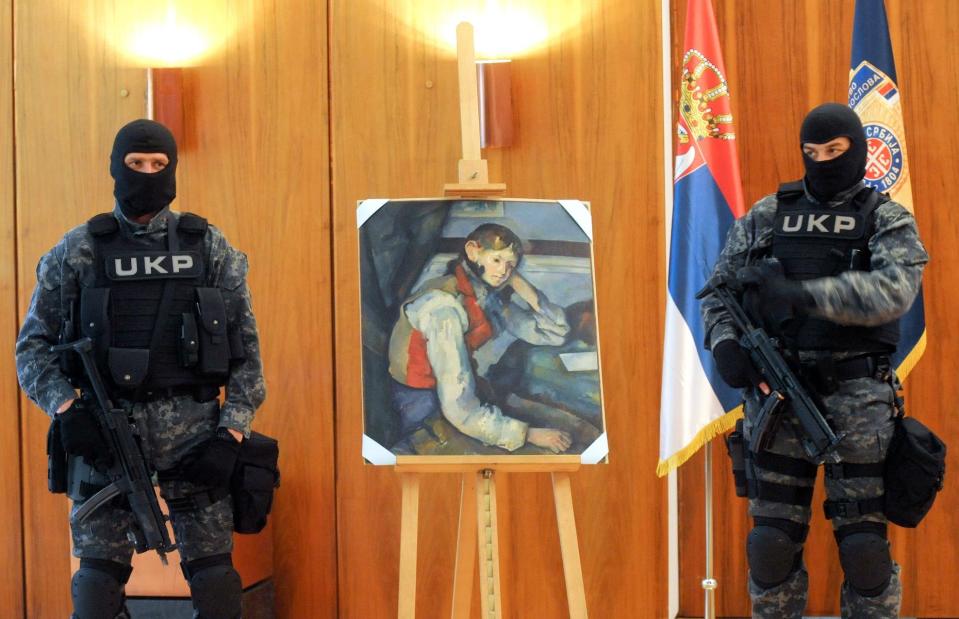
ALEXA STANKOVIC/AFP/Getty Images
At the time of its disappearance in 2008, the robbery of The Boy in the Red Vest by Paul Cézanne from a private museum in Zürich was one of the biggest art thefts in Europe.
Worth about $91 million (£74m), the Impressionist painting from 1888 was stolen in a spectacular heist along with three other masterpieces, including Monet's Poppy Field at Vetheuil and Van Gogh's Blossoming Chestnut Branches. The trio of masked robbers even made the staff lie down on the floor before taking the collection's most valuable pieces.
After the dramatic robbery, Swiss police soon found the stolen Monet and Van Gogh in a car park. However, it was four years until the Cézanne was recovered in Serbia, with a Swiss art expert flown in to confirm its authenticity.
Three members of a criminal gang were arrested in Belgrade and the town of Cacak as part of a large-scale police operation. According to Serbian media, the suspects were in possession of firearms and vast sums of cash.
Sweden’s royal jewels, part I
![<p>Ulrika Pasch/Wikimedia Commons [Public domain]</p>](https://s.yimg.com/ny/api/res/1.2/LJNfhLWQ60DRQnB_8s4rUQ--/YXBwaWQ9aGlnaGxhbmRlcjt3PTk2MDtoPTYxOQ--/https://media.zenfs.com/en/lovemoney_uk_264/5605a9350de36adeb91c4ebcf6f63f38)
Ulrika Pasch/Wikimedia Commons [Public domain]
In 2013, 16th-century replicas of King Johan III of Sweden's funeral orb, sceptre, and crown were stolen from Västerås Cathedral, just west of Stockholm.
The robbery took place in the dead of night, with the losses discovered the next day by a member of staff. Cathedral chaplain Johan Sköld declared the items to be "invaluable" and the police quickly issued a nationwide alert.
An anonymous tip-off several days later led them to find the artefacts inside two large rubbish bags that had been dumped on Highway 555 between Västerås and nearby Hallstahammar. The items were promptly returned to the Cathedral, and there have been no arrests or confessions to this day.
Paysage Bords de Seine by Renoir
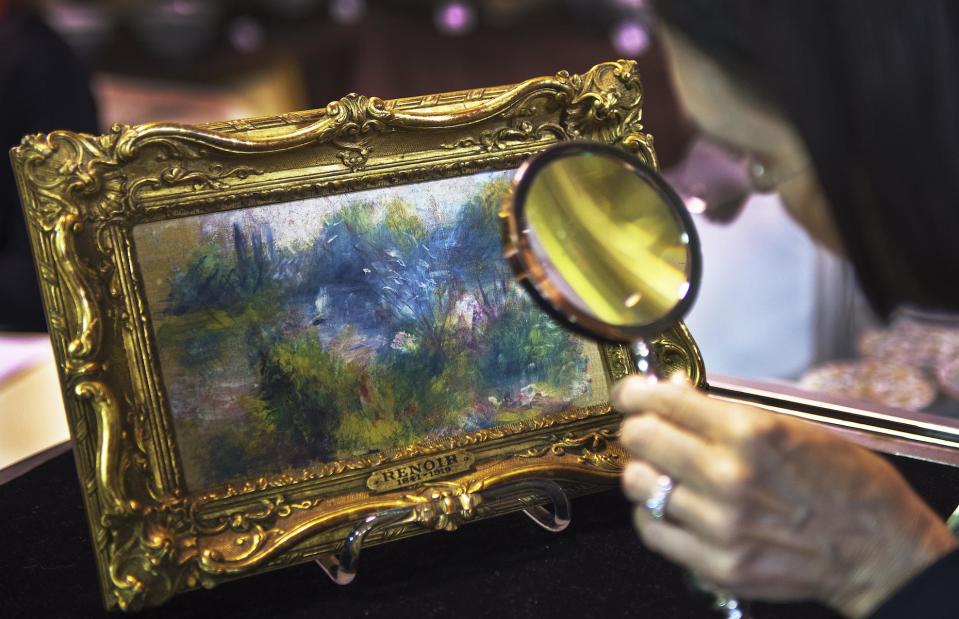
PAUL J. RICHARDS/AFP/Getty Images
Painted by the French Impressionist Pierre-Auguste Renoir in 1879, Paysage Bords de Seine was reported missing from the Baltimore Museum of Art in 1951. It reappeared almost 60 years later at a flea market in West Virginia in 2009, with zero indication of where it had been for six decades.
Not knowing what she had happened upon, Marcia Fuqua claimed she bought the valuable artwork along with a plastic cow and a Paul Bunyan doll for just $7 (£5.70). She later said she liked the frame of the napkin-size painting. Even though the nameplate said "Renoir 1841-1919", Fuqua didn't think the painting was genuine and stored it in a rubbish bag for two years before deciding to have it valued.
To her frustration, a federal judge ruled in 2014 that the painting had to be returned. The FBI handed it over to the Baltimore Museum of Art, where it's now once more on display.
Bronze horses by Josef Thorak
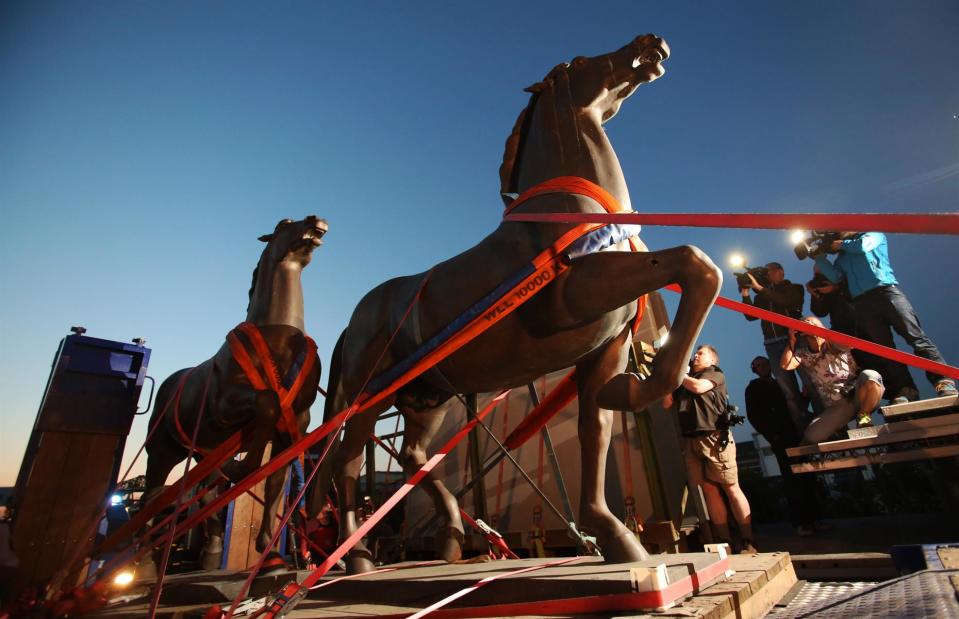
FREDRIK VON ERICHSEN/AFP/Getty Images
These 16-foot-high horses – commissioned by Adolf Hitler – once flanked the entrance of the chancellery building in downtown Berlin. They were lost sometime between being photographed by art historians in 1988 and 1991, when the Soviets began their retreat from East Germany.
In 2015, former collector and part-time art sleuth Arthur Brand spectacularly recovered the steeds. They were up for sale, so Brand posed as a millionaire Texan oil dealer named Mr. Moss, who he revealed he based on the Dallas character J. R. Ewing.
While the middleman for the sale ultimately stalled, Brand and the police followed other leads. They eventually located the horses in Bad Dürkheim in a raid that resulted in the seizure of 30 more artworks.
Two Van Gogh paintings
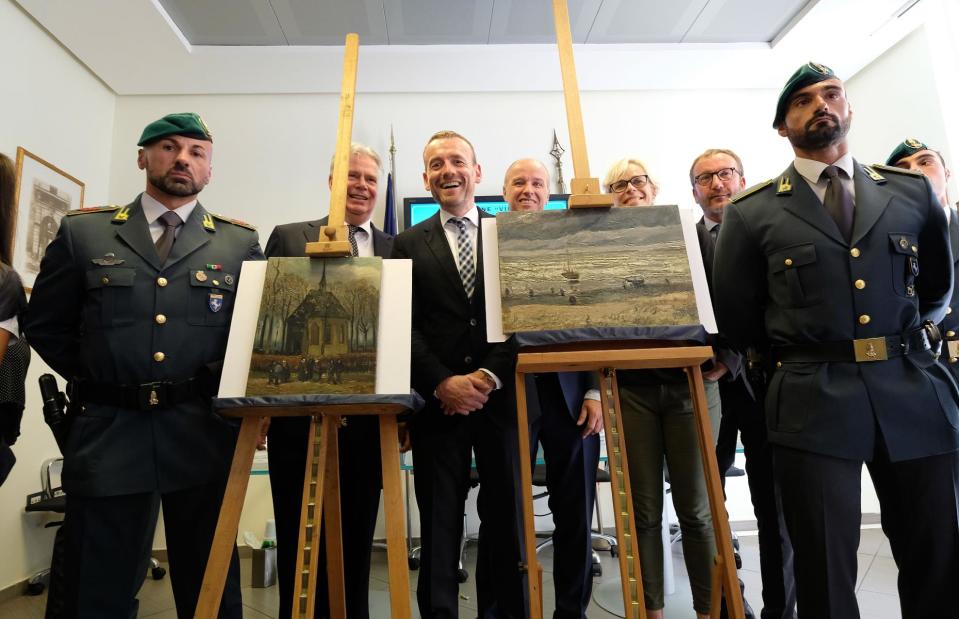
MARIO LAPORTA/Stringer/Getty Images
Two Van Gogh paintings that were stolen from the Van Gogh Museum in Amsterdam in a 2002 heist were finally found in a farmhouse near Naples, Italy, in 2016. View of the Sea at Scheveningen (1882, pictured right) and Congregation Leaving the Reformed Church in Nuenen (1884-85, pictured left) were found in a box hidden behind a wall in a toilet of the farmhouse.
The paintings weren't the only assets seized by Italian police, who took possession of €20 million ($23.8m/£17.4m)-worth of goods, including a small plane, apartments and villas, which they contend belonged to two alleged Camorra drug kingpins.
The paintings had never been sold, so their exact value is unknown, but Van Gogh works can comfortably sell for tens of millions. In early 2017, the paintings were finally returned to the walls of the Van Gogh Museum, which museum director Axel Rüger (pictured centre) described as one of the "most special days in the history of our museum".
Scheringa Museum of Realist Art’s paintings
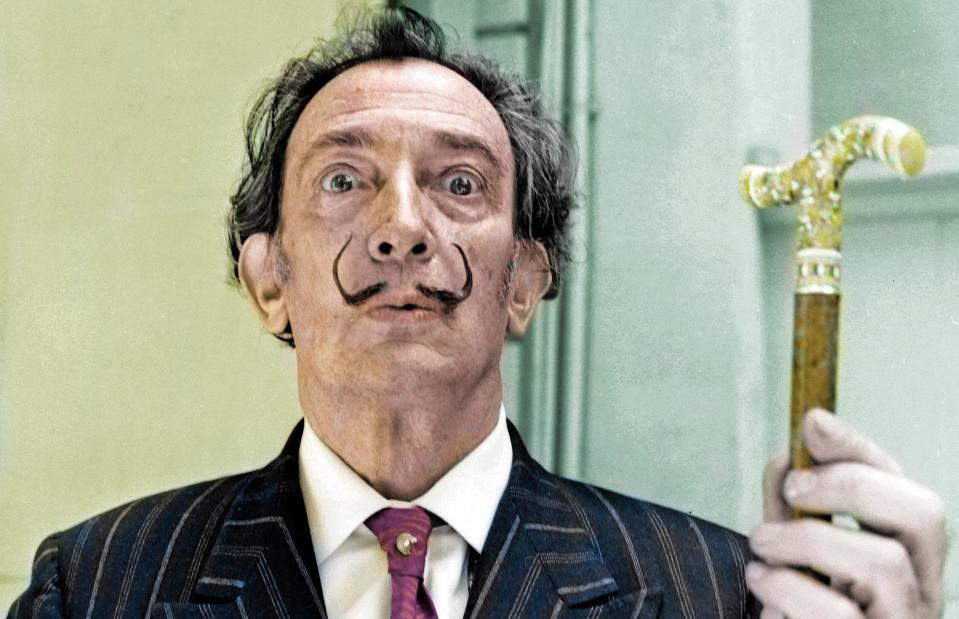
Jack Mitchell/Getty Images
Two paintings – Adolescence by Salvador Dalí (pictured) and La Musicienne by Tamara de Lempicka – were stolen in 2009 from the Scheringa Museum of Realist Art in Spanbroek in the Netherlands. Masked gunmen entered the museum in broad daylight and made off in a car with the works. Together, they were valued at more than $8.5 million (£6.5m).
In 2016, art detective Arthur Brand tracked down the paintings and successfully negotiated their return. Both had become currency in the underworld, and Brand liaised with a criminal gang for months before the paintings were eventually handed into UK police at Scotland Yard, wrapped in an old blanket.
Woman-Ochre by Willem de Kooning
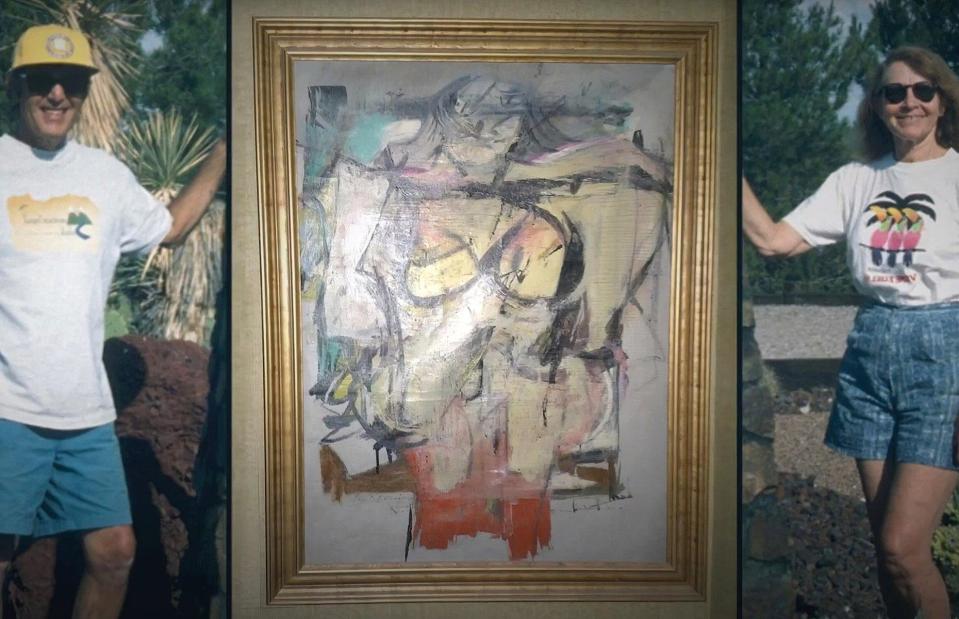
Everett Collection Inc/Alamy Stock Photo
Worth an estimated $160 million (£130m), Willem de Kooning's Woman-Ochre had been missing for more than 30 years after it was cut out of its frame at the University of Arizona Museum of Art in Tucson in 1985. At the time, the museum had no security cameras.
However, the expressionist oil painting was later recovered in the New Mexico home of two former schoolteachers, Jerry and Rita Alter (pictured with the painting), after Rita died in 2017 (Jerry had passed away five years earlier in 2012).
No one knows exactly how the painting ended up in the home of the quiet, unassuming couple, but the pair were photographed in Tucson the night before the heist. Some suggest the couple also resembled sketches of the suspects that the investigators released at the time.
Ruby slippers from The Wizard of Oz
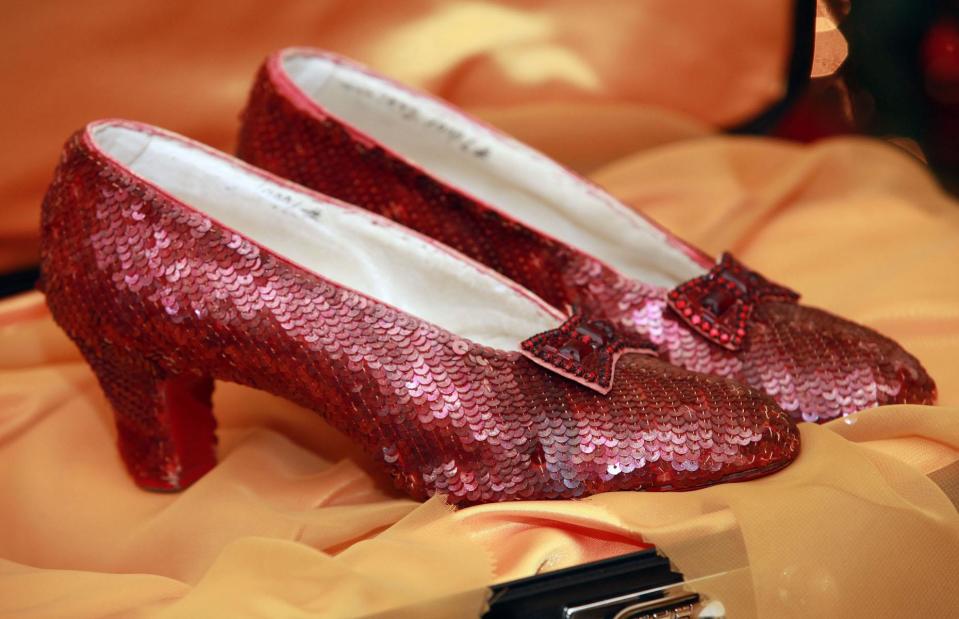
Astrid Stawiarz/Getty Images
These sparkling ruby slippers worn by Judy Garland in 1939's The Wizard of Oz are among the most valuable memorabilia items in movie history. In 2005, one of seven pairs made for the film was stolen from the Judy Garland Museum in Grand Rapids, Minnesota after a thief broke in through a window at night.
After years of investigation, during which an anonymous fan offered a $1 million (£773k) reward for the shoes to be returned (although this expired after 10 years), the FBI finally got a lead.
They tracked down the ruby slippers in September 2018 after an undercover operation in Minneapolis. A man had approached the insurer of the valuable shoes, claiming he could help to get them back, and the investigators were able to recover the precious stolen goods. The thief has been revealed as Terry Martin, now in his late 70s, who was indicted in 2023. A second man, 76-year-old Jerry Hal Saliterman, was also indicted in March 2024. He was charged with stealing a major artwork and witness tampering, after allegedly threatening to release an explicit tape of a woman if she did not keep quiet about the theft.
An 18th century Ethiopian crown
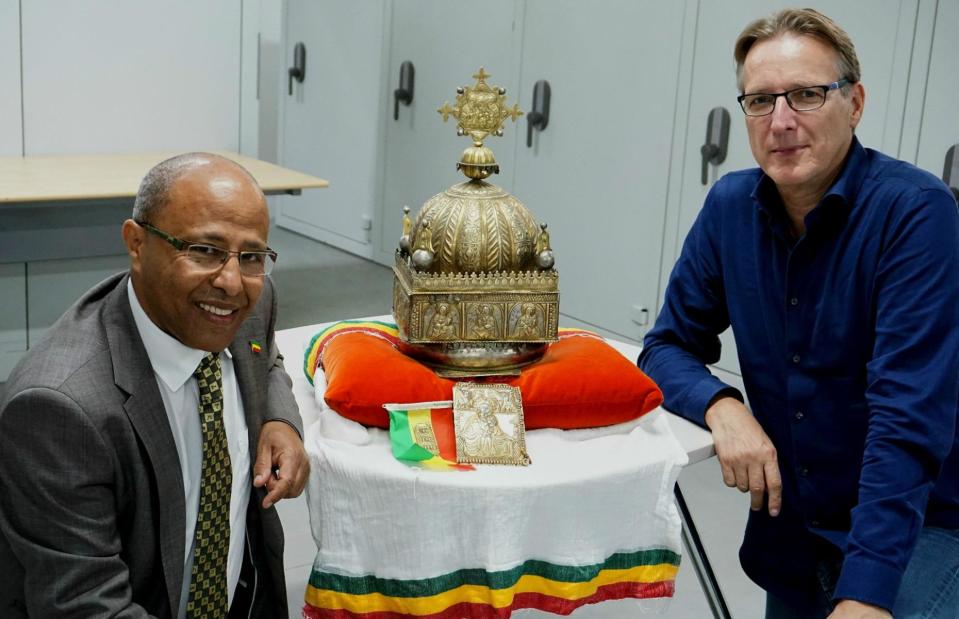
Jan Hennop/AFP/Getty Images
Missing since 1993, this 18th-century Ethiopian bronze crown was finally handed back to the Ethiopian government in 2020. Political refugee Sirak Asfaw, who had fled the country for the Netherlands in the 1970s, discovered the crown in the suitcase of a refugee who was staying in his Rotterdam flat in 1998. The crown features images of Christ and the 12 apostles, and there are thought to be just a dozen versions in existence.
Sirak assumed the crown had been stolen but feared that it might "just disappear again" if handed back to the Ethiopian authorities, so he kept hold of it. Once Prime Minister Abiy Ahmed took office in 2018, Sirak felt more comfortable about giving it back, contacting a Dutch art specialist to arrange its return. In February 2020, the artefact was handed over in a ceremony in the Ethiopian capital Addis Ababa.
Spanish Visigothic reliefs
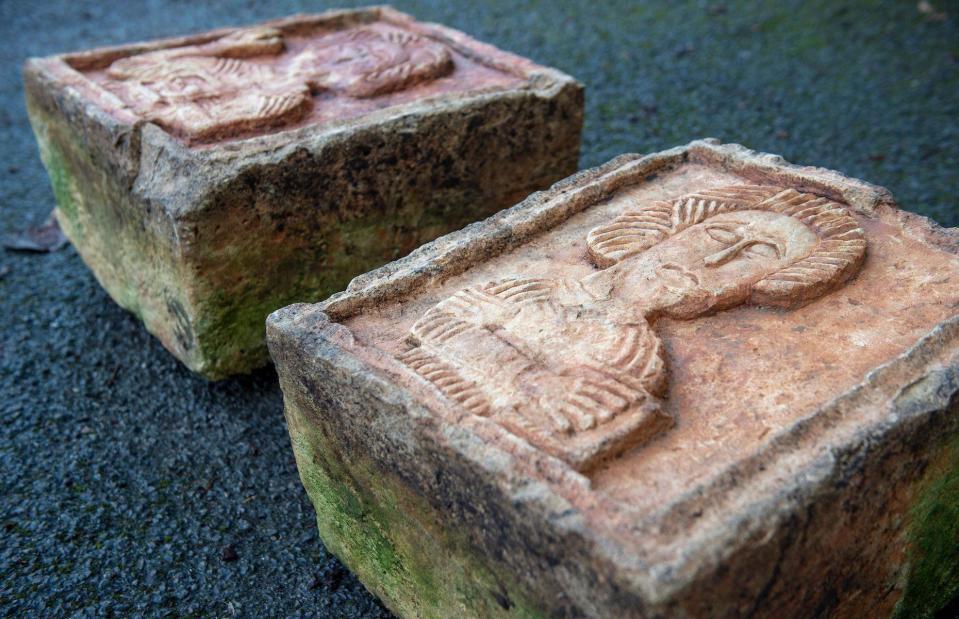
NIKLAS HALLE'N/AFP/Getty Images
In 2004, these two Visigothic carvings dating back to the 7th century were stolen from the Santa Maria de Lara church in northern Spain. The priceless reliefs, each weighing about 110lbs (50kg), were tracked down by the Dutch art detective Arthur Brand in 2019 to an English nobleman's garden, where they were found covered in mud and leaves after being used as ornaments.
The British aristocrat unwittingly bought the ancient treasures as garden ornaments for around £50,000 ($68k) each from a French dealer. When he learned the truth, he was reportedly so shocked that he wanted to "throw the artworks into a river and let them disappear forever". Fortunately, the priceless reliefs were handed to the Spanish Embassy in early 2019.
Sweden’s royal jewels II
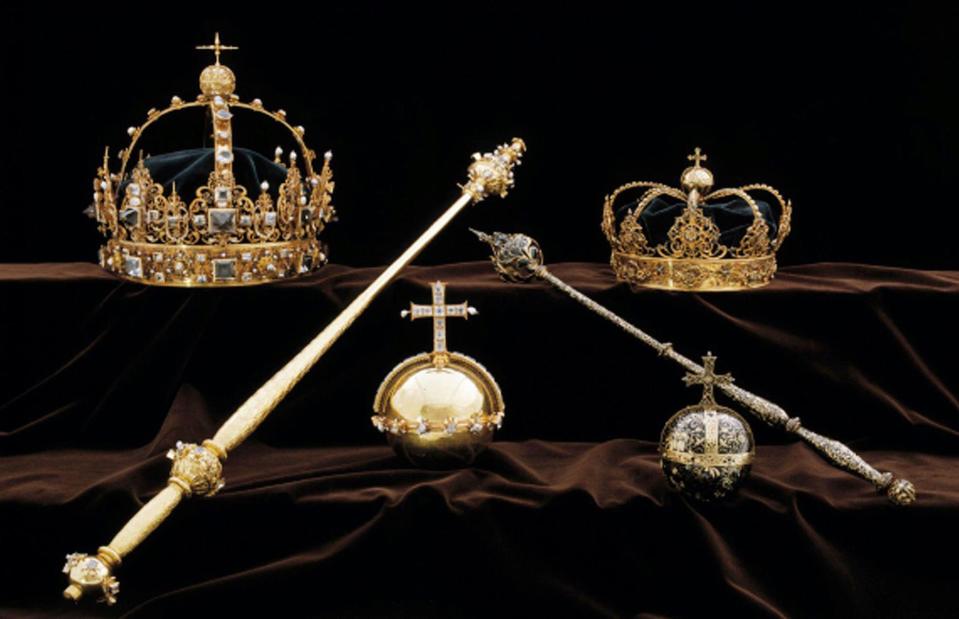
Associated Press/Alamy Stock Photo
Sweden's royal jewels have been targeted by criminals on more than one occasion. In July 2018, two thieves ran into Strängnäs Cathedral near Stockholm to grab an orb and two crowns, which once belonged to 17th-century monarchs Karl IX and Queen Christina and made up the king’s funeral regalia in 1611. After nabbing the priceless pieces, the thieves cycled to a speedboat standing by at a nearby lake and made a swift getaway.
In February 2019, the items were recovered from a rubbish bin in a suburb of Stockholm. They had been dumped among other waste despite being composed of gold, pearls, and precious stones. The bin was marked "bomb" and had been placed on top of a car, which brought it to immediate attention.
A 22-year-old man was jailed for four years after his DNA was found on the jewels and he confessed to the theft.
Stolen piece of Stonehenge
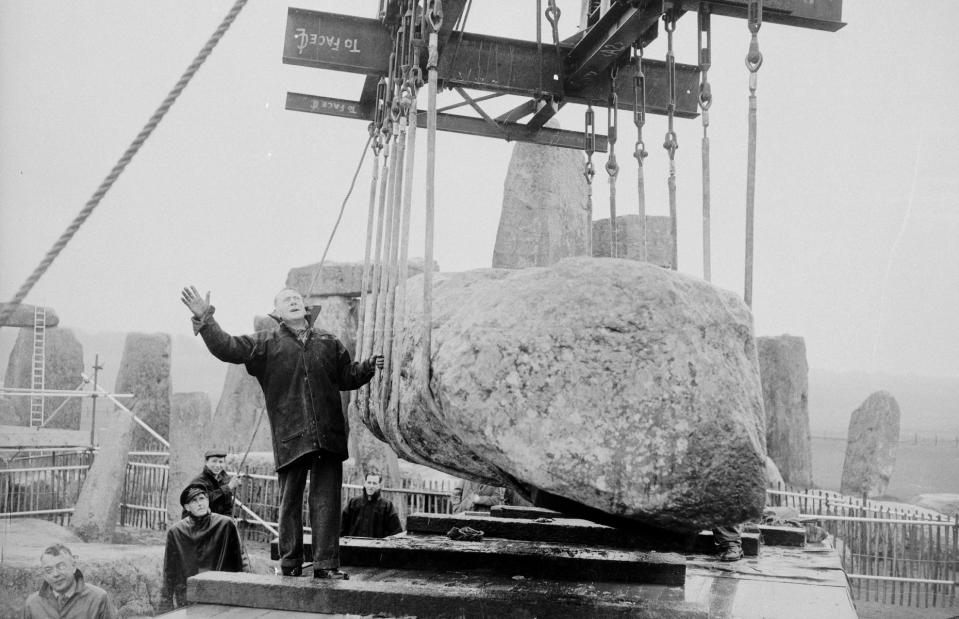
John Franks/Stringer/Getty Images
In 1958, extensive restoration work took place on the world-famous Stonehenge in Wiltshire, England. On completing his part of the work, excavation team member Robert Phillips decided to take a piece of the prehistoric monument home with him. Phillips left with a 108cm core from one of the sarsen stones, which had been drilled out so that metal rods could be inserted to keep them upright.
Phillips then took the 5,000-year-old slither of stone to America when he emigrated in 1976. Experts assumed the core was gone for good. But the night before his 90th birthday in 2019, Phillips told family members that it was time to return the piece of Stonehenge, which he had been displaying in his office for around 60 years.
His sons Robin and Lewis personally delivered the core, which had been kept in pristine condition. Two other drilled-out cores remain missing.
Gustav Klimt's Portrait of a Lady
![<p>Gustav Klimt/Wikimedia Commons [Public domain]</p>](https://s.yimg.com/ny/api/res/1.2/WlVk2iImNsYSH37Ban.KLA--/YXBwaWQ9aGlnaGxhbmRlcjt3PTk2MDtoPTYxOQ--/https://media.zenfs.com/en/lovemoney_uk_264/edab2d23195b4d5c7e32fee4141543e6)
Gustav Klimt/Wikimedia Commons [Public domain]
In December 2019, gardeners at Galleria d’Arte Moderna Ricci Oddi gallery in Piacenza, Italy, made a strange discovery. As they cleared ivy from the gallery's exterior walls, they came across a painting hidden in an alcove that had been concealed by a metal panel. The artwork was in good condition and experts suspected it was a 1917 piece by the Austrian painter Gustav Klimt.
Titled Portrait of a Lady (pictured), the painting had actually been stolen from the gallery around 20 years earlier. It was authenticated as a genuine Klimt in January 2020, meaning that, although it had been taken from the gallery walls in February 1997, it had never actually left the gallery's grounds.
While the painting, which Klimt finished the year before his death in 1918, has been recovered, the story behind its theft remains a mystery. Investigators are now examining organic material found on the recovered canvas in the hope it will reveal the truth.
Rembrandt exhibition paintings
![<p>Rembrandt/Wikimedia Commons [Public domain]</p>](https://s.yimg.com/ny/api/res/1.2/x5ah5KxH8SGNTLD5S7F8Rg--/YXBwaWQ9aGlnaGxhbmRlcjt3PTk2MDtoPTYxOQ--/https://media.zenfs.com/en/lovemoney_uk_264/9e68a7e0beb7ae3908c3c4a8e1e31b72)
Rembrandt/Wikimedia Commons [Public domain]
The Rembrandt’s Light exhibition at Dulwich Picture Gallery in London was put together in 2019 to display 35 of the Dutch master’s paintings 350 years after his death. A thief targeted two of the iconic artworks in what police described as an "audacious" burglary, and even attacked an officer with an unknown substance from a canister to escape with the paintings…
While many of the stolen artworks featured in this round-up were eventually found in different cities or even different countries from where they were taken, these two stolen Rembrandts didn’t even make it off the premises.
The paintings were quickly recovered – with one reportedly retrieved from the bushes – within the gallery grounds and have since made their way back to their original homes: the Louvre in Paris and Washington’s National Gallery of Art .
Irreplaceable first-edition books
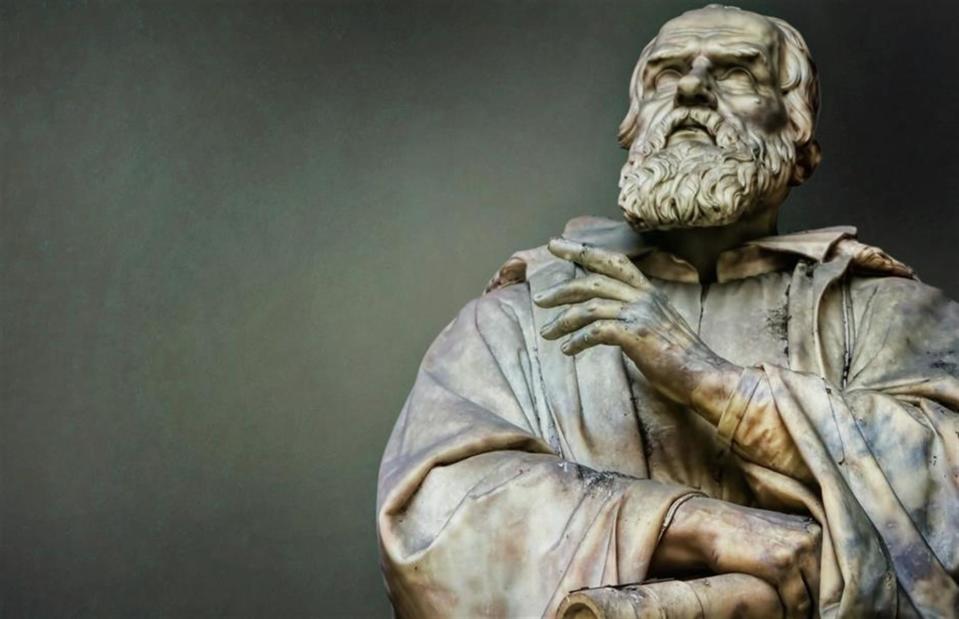
ArTono/Shutterstock
Back in 2017, irreplaceable books worth more than £2.5 million ($3m) were stolen from a transit warehouse in London. The five-hour heist was like a scene from a spy film, with two men drilling holes in the ceiling and abseiling down into the building to snatch the collection of 200 books. The criminals stashed the books in 16 holdall bags and escaped with the help of a third man, who was assigned the job of getaway driver.
A three-year investigation ensued in an attempt to find the collection, which included rare first editions by the likes of Sir Isaac Newton and Galileo. Their hiding place? A cement pit beneath a house in Romania. In September 2020, the perpetrators were revealed to be members of an organised crime group, and 13 men have since been charged.
Chairman Mao scroll
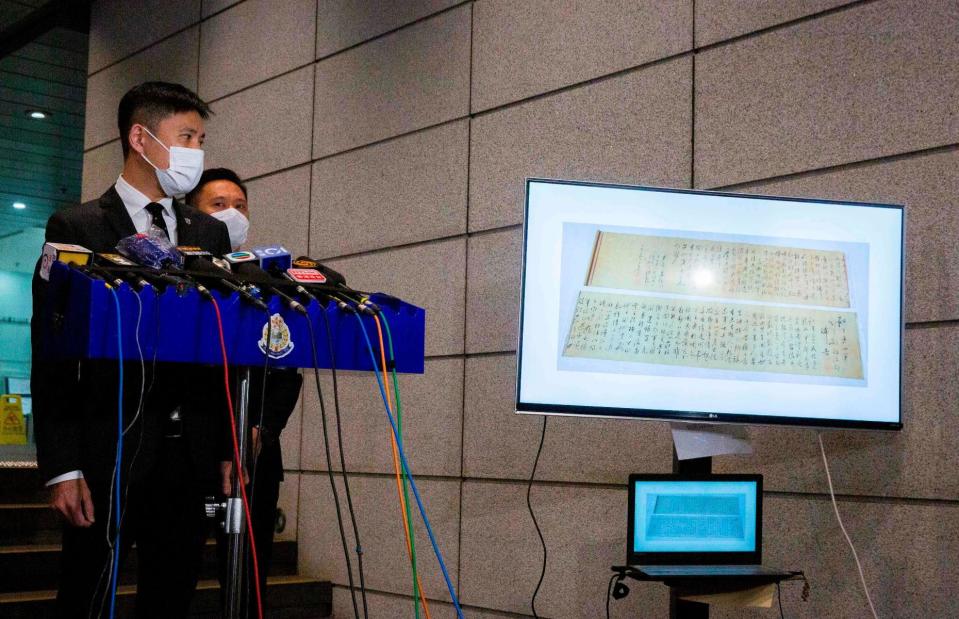
ISAAC LAWRENCE/Getty Images
In September 2020, burglars stole a highly-coveted calligraphy scroll written by Mao Zedong, the founder of the People’s Republic of China.
The manuscript was on display at renowned art collector Fu Chunxiao’s home when it was taken by three men, who had broken into the property. Among other pieces taken were antique stamps, copper coins, and other writings by Mao, bringing the value of the stolen goods to a reported HK$5 billion ($645m/£498m).
The thieves sold the scroll to a Hong Kong-based art collector for just HK$500 ($64/£50). He believed it was fake but contacted police once the appeal for information on the burglary went public.
The manuscript was returned to Fu but sadly not in its original condition – at some point during the theft, the nine-foot-long (2.8m) parchment had been cut in half, which likely dented the scroll's previous estimated value of $300 million (£231m). Three people were eventually jailed for the theft in 2022.
“Cursed” Pompeii artefacts

Viacheslav Lopatin/Shutterstock
The ancient city of Pompeii is one of Italy’s most visited spots – and over the years, visitors have taken much more than just photos of the historic site. Fragments of stone are often stolen by light-fingered tourists, with many later returning them due to guilty consciences. In October 2020, one such tourist sent a package of pieces she'd taken to a travel agent in Pompeii.
The Canadian woman, known only as Nicole, enclosed a letter with the artefacts, explaining that the pieces were cursed and that she had had non-stop bad luck since stealing them in 2005. She returned two mosaic tiles, parts of an amphora, and pieces of ceramics in the package, and blamed the relics’ "negative energy" for years of poor health and financial problems.
In her note to the travel agent, Nicole also said that she was sending the pieces back because she didn’t want to "pass this curse on" to her family or children, according to The Guardian.
Gustav Klimt's Rosebushes Under the Trees
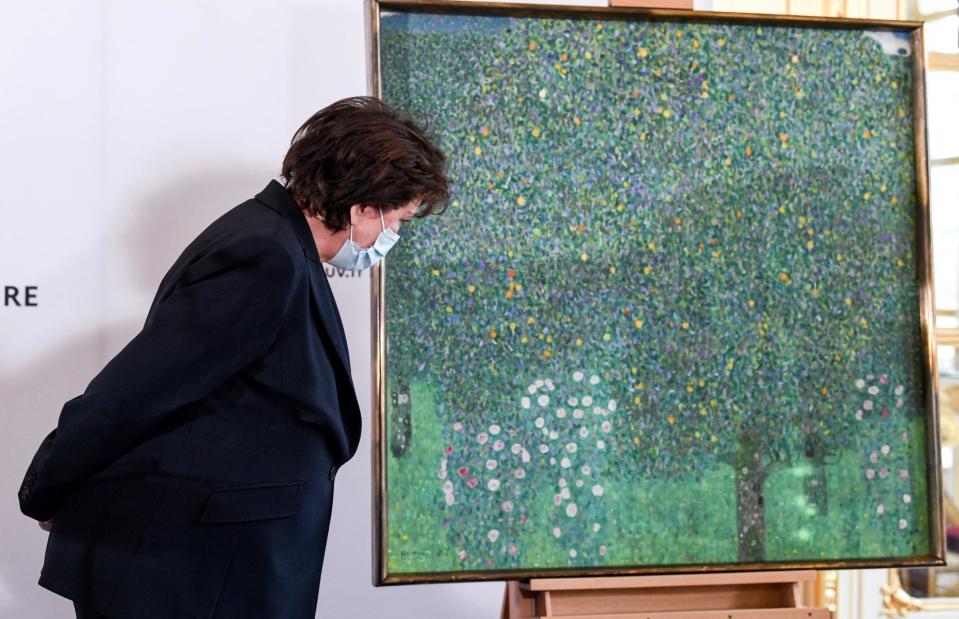
ALAIN JOCARD/POOL/AFP via Getty Images
In 2021, the French government announced it would return the only Gustav Klimt painting in its national collection to the Jewish family the Nazis stole it from back in 1938. The 1905 painting, Rose Bushes Under the Trees, was displayed in the Musée d’Orsay in Paris since 1980, when it was purchased at auction. French culture minister Roselyne Bachelot (pictured with the painting) said the authorities weren't aware it had been stolen by the Nazis until recently.
The oil painting will be returned to the family of Nora Stiasny, who was a victim of the Holocaust.
"The decision to return a major work from the public collections illustrates our commitment to the duty of justice and reparation vis-a-vis plundered families," Bachelot said, alluding to France's ongoing endeavours to reunite stolen artworks with the families of those they were taken from.
Frescoes from Pompeii
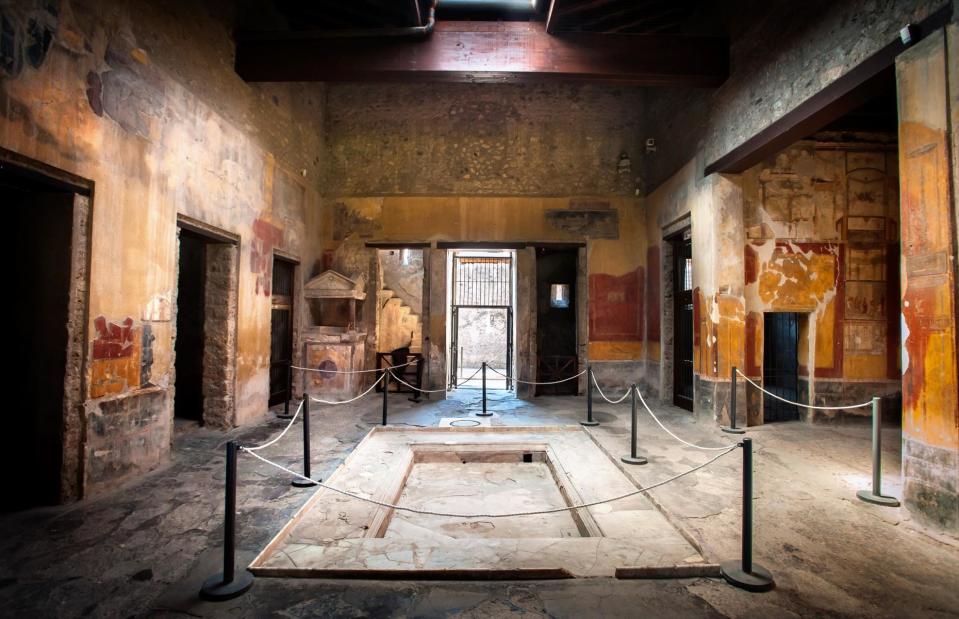
StrippedPixel.com/Shutterstock
Three frescoes dating back to the first century AD are thought to have been sliced off the walls of two Roman villas in the ancient city of Stabiae, close to Pompeii, in the 1970s, before they were illegally exported out of the country.
Another three frescoes were then snatched from a villa in Civita Giuliana, just northwest of Pompeii’s main archaeological park, and authorities were left confused as to the whereabouts of the pieces of ancient watercolour-painted plaster.
The Civita Giuliana frescoes were recovered by police in 2012 after they uncovered a tunnel that led straight to the ancient villa. The passageway had served as a secret way of stealing the artworks. The three pieces taken from Stabiae were recovered during a police crackdown on illegal antiquities in 2020, and all six of the frescoes have since been returned to Pompeii.
$70 million-worth of plundered antiquities
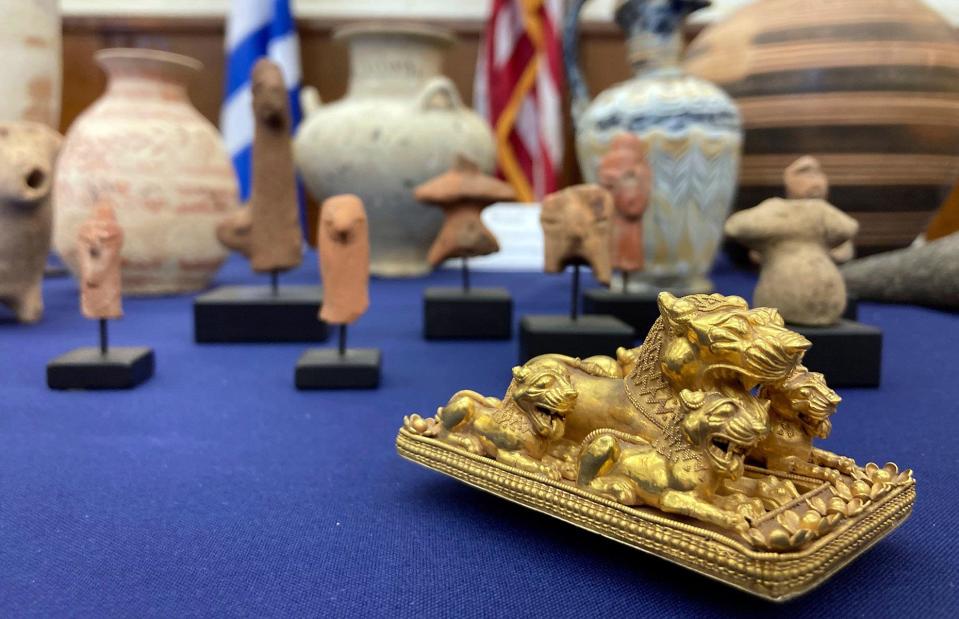
AP Photo/David R. Martin/Alamy Stock Photo
American billionaire Michael Steinhardt is one of the world's most famous art collectors – but not all of his multimillion-dollar archive has been acquired within the law. In 2017, the District Attorney of Manhattan launched an investigation into Steinhardt's collection of art and antiquities. Around three years later, in December 2021, it was revealed that around 180 of the items in his possession, collectively worth $70 million (£52m), had been looted illegally.
In February 2022, New York County District Attorney Alvin Bragg announced that 55 of these stolen antiquities would be returned to Greece.
Between them, the Grecian objects are worth a total of $20 million (£15m). It was settled that Steinhardt would escape prosecution if he agreed to hand over the stolen artefacts, and he's also been banned from buying antiques for the rest of his life.
The Dresden Castle jewels

Juergen Karpinski/ AFP via Getty Images
At around 4.50am on 25 November 2019, around 100 artefacts were stolen from the Green Vault at Dresden Castle in Dresden, Germany. CCTV footage from the scene of the crime showed thieves smashing a glass display case before making off with an assortment of treasures, including this bow-shaped brooch, which is believed to date to the 1780s and is made up of 660 individual diamonds.
The authorities offered a reward of €500,000 ($530k/£437k) "for clues that lead to the investigation of the crime". But with experts warning that the jewels were so recognisable that the criminals would probably smash them up before reselling them, it seemed unlikely they would ever be restored.
At the time, the stolen hoard was thought to be worth around €113 million ($128m/£100m). The thieves were rigorous about covering their tracks, hiring a getaway car and setting fire to it shortly after the heist to destroy any DNA evidence. But in September 2021, the police arrested six men in connection with the theft, two of whom were already in prison for stealing a 100kg Canadian gold coin from a Berlin museum in 2017.
Even though the culprits had been caught, the police didn't manage to track down any of the stolen jewels until December 2021. After negotiating with the thieves' lawyers, the authorities eventually restored 31 of the missing pieces to their rightful home at Dresden Castle. In May 2023, five of the men arrested in connection with the crime were finally sentenced to jail, eight months after their trial began in September 2022.
Aboriginal spears

Courtesy The Museum of Archaeology and Anthropology/University of Cambridge
When James Cook landed in Kamay (Botany Bay), Australia in 1770, he came away with more than just stories of his travels; he also looted forty spears from Aboriginal people living in the area, four of which were given to Trinity College at the University of Cambridge upon his return to England.
Believed to be the earliest surviving artefacts collected by a European in Australia, the spears were on display at a Cambridge museum for over 250 years. But now, they've finally been returned to the La Perouse Aboriginal community.
Noeleen Timbery, chairperson of the La Perouse community, said in a statement shared in March 2023: "Our Elders have worked for many years to see their ownership transferred to the traditional owners of Botany Bay. Many of the families within the La Perouse Aboriginal community are descended from those who were present during the eight days the Endeavour [Cook's ship] was anchored in Kamay in 1770".
The spears will be shipped to the National Museum of Australia in Canberra while the community finishes building its own visitor centre, which will eventually house them.
Cambodian crown jewels

Bule Sky Studio/Shutterstock
In 2022, a collection of Cambodian crown jewellery was rediscovered in London in the possession of notorious British antiques smuggler Douglas Latchford. The 77 pieces, some of which date to the 7th century, were handed over by Latchford's family following his death in 2020. It's unknown how Latchford came into possession of the items, but many of them match stone carvings found at Angkor Wat (pictured). Cambodian authorities believe there may be more items waiting to be found.
For now, the recovered items have been returned to Cambodia. The head of the nation's investigative team, Brad Gordon, visited London to see the pieces before they were shipped home. Speaking to the BBC, he said: "I was driven by a representative of the Latchford family to an undisclosed location. In the parking lot was a vehicle with four boxes inside. I felt like crying. I just thought – wow – the crown jewels of ancient Cambodian civilisation packed into four boxes in the back of a car".
Egyptian sarcophagus
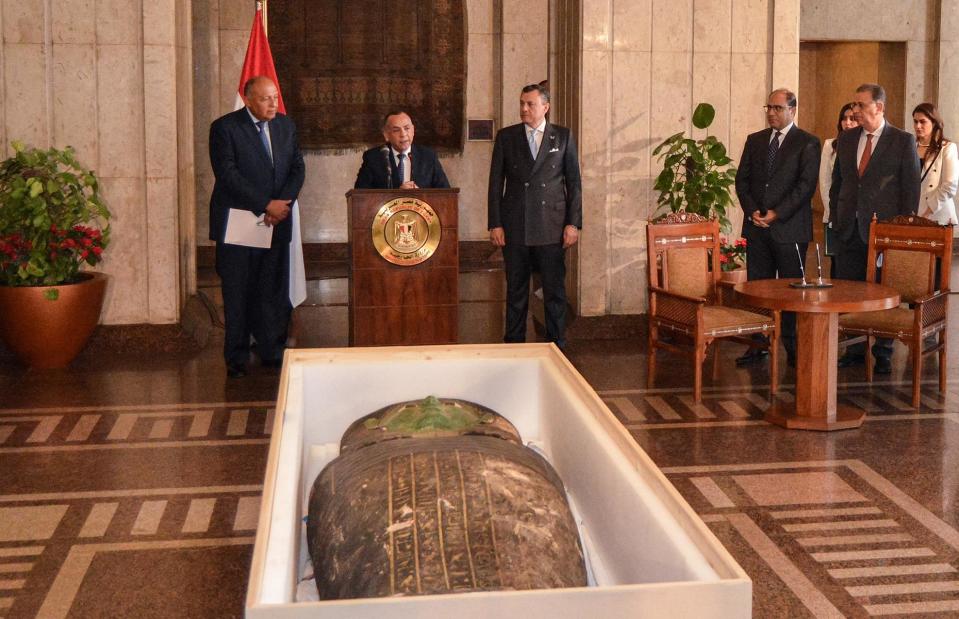
Contributor/Getty Images
Fifteen years ago, an ancient Egyptian sarcophagus was smuggled into the US and put on display in the Houston Museum of Natural Sciences.
Measuring almost 10 feet tall (3m) and believed to belong to a priest called Ankhenmaat, the sarcophagus "was trafficked by a well-organised network that has looted countless antiquities from the region," according to Alvin Bragg.
An investigation has shown that it was looted from Abu Sir Necropolis, north of Cairo, before being smuggled to Germany and then the US. The painted sarcophagus was returned to authorities in Cairo during a handover ceremony in January last year (pictured).
Benin bronzes
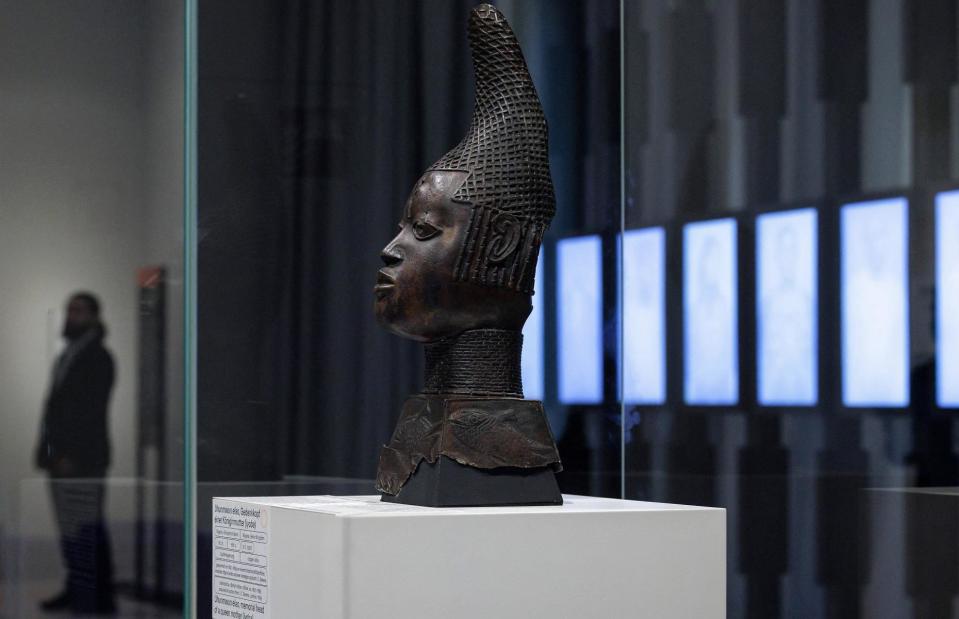
JENS SCHLUETER/Contributor /Getty Images
In December 2022, Germany returned 21 historic bronze artefacts to Nigeria. The pieces had been looted by British soldiers from the former kingdom of Benin 125 years ago before being sold to museums in Berlin, Hamburg, Stuttgart, and Cologne.
Germany has formally transferred the ownership of around 1,000 Benin bronzes to Nigeria, and the 21 items handed over during a ceremony in Nigeria's foreign ministry are just a small sample of the group. They'll eventually be displayed at a new pavilion in Benin City.
Precious Blood of Christ relic
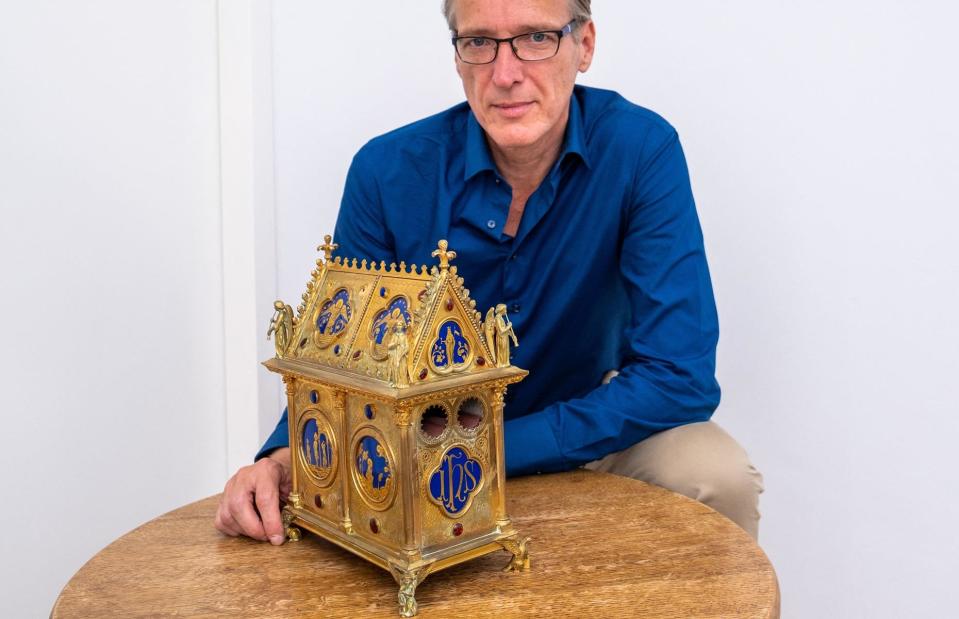
JEREMY AUDOUARD/Contributor/Getty Images
This 2,000-year-old golden shrine, which is said to contain drops of blood collected from Jesus Christ during his crucifixion, was stolen from Fécamp Abbey in Normandy, France in June 2022. The police believe the culprits locked themselves in overnight before making off with the Catholic relic and various other works of art – just two weeks before the Abbey's annual Mass of the Sacred Blood celebration.
Thankfully, art detective Arthur Brand (pictured here with the recovered relic) was on the case, having received an email from somebody who revealed that the relic was being stored by a friend of the thief. Following negotiations, the friend left the shrine on Brand's doorstep in the Netherlands. "A couple of days [after the email], at 10:30 in the evening, the doorbell rang. I looked from my balcony outside and in the dark I saw a box," said Brand. "I ran down the stairs, afraid that someone would take the box. Outside I looked around, but there was no-one there."
The moment he opened the box to reveal the shrine was "an authentic, religious experience" for the detective, who later handed the relic over to the Dutch authorities.
Charles Darwin's notebooks
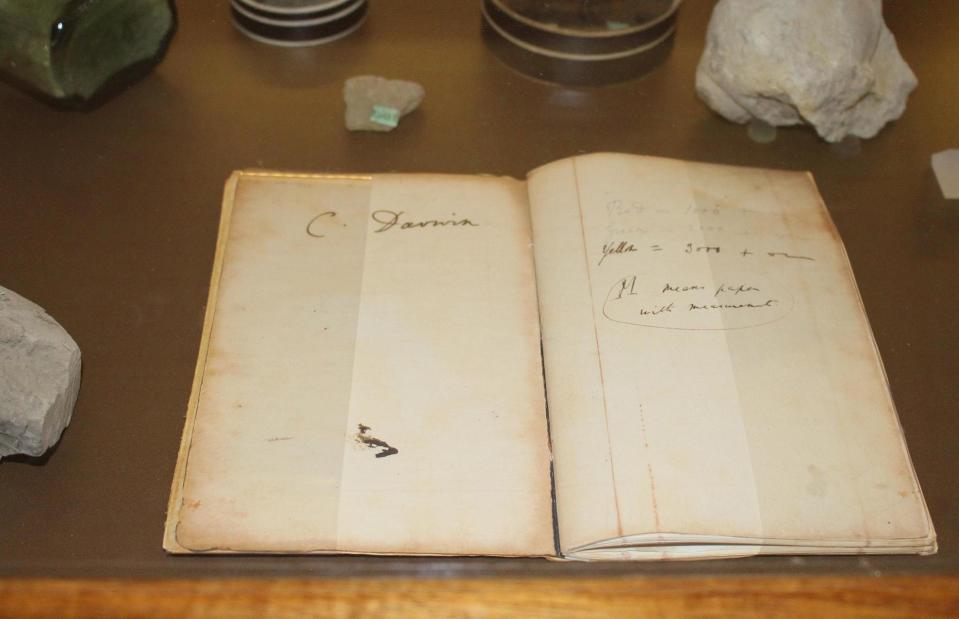
Tara Sedgwick/Alamy Stock Photo
In March 2022, librarians at the University of Cambridge received an Easter surprise when two notebooks belonging to Charles Darwin were returned – nearly 22 years after they had been taken.
One of the books included Darwin's sketch of the Tree of Life, a diagram he used to develop his theory of evolution.
Dating back to 1837, the notebooks were found to be missing during a routine check in 2001. In 2020, the Cambridge University Library made a public appeal for information and just 15 months later, the books were anonymously left at the library in a pink gift bag with a card that read: "Librarian, Happy Easter X". The identity of the thief has never been discovered.
Now discover the amazing charity shop finds that sold for a fortune

 Yahoo Finance
Yahoo Finance 